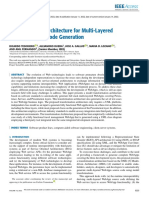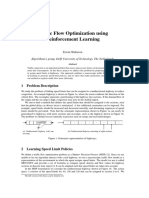ESP-JETA
ESP Journal of Engineering & Technology Advancements
ISSN: 2583-2646 / Volume 5 Issue 1 January 2025 / Page No: 41-55
Paper Id: JETA-V5I1P105 / Doi: 10.56472/25832646/JETA-V5I1P105
Original Article
Implementing AI-Driven Micro-Frontend Architectures Using
Reinforcement Learning and Graph Neural Networks for
Scalable and Maintainable Large-Scale Web Applications
1 2 3 4
Muthu Selvam , PrakasamVenkatachalam , Sathiskumar Meganathan , Thalapathi Rajasekaran R
1
College of Computing and Informatics,University of North Carolinaat Charlotte,Charlotte, North Carolina 28223, USA.
2
College of Computing and Informatics, University of North Carolina at Charlotte, Charlotte, North Carolina 28223, USA.
3
The University of Texas at Austin, 2515 Speedway, Austin, TX 78712, USA.
4
Professor, Dept. of Computer Science and Engineering, Saveetha School of Engineering, Saveetha University, Saveetha Institute
of Medical and Technical Sciences (SIMATS), Chennai 602105, India.
Received Date: 16 November 2024 Revised Date: 24 December 2024 Accepted Date: 10 January 2025
Abstract: The rapid evolution of web applications across diverse domains like e-commerce, healthcare, and enterprise
solutions necessitates architectures that are scalable, maintainable, and performance-efficient. Micro-Frontends (MFEs)
have emerged as a modular alternative to monolithic frontends, enabling independent development, deployment, and
testing of UI components. However, challenges such as dependency conflicts, static orchestration strategies, and inefficient
module management limit the full potential of traditional MFE architectures. This research introduces Dynamic AI-
Orchestrated Modular Architecture (DAIMA), a novel framework that leverages artificial intelligence to enhance the
scalability and maintainability of large-scale applications. DAIMA incorporates two key innovations: Reinforcement
Learning for Dynamic Orchestration, which employs deep Q-learning networks to optimize module loading sequences in
real time based on user behavior patterns, and Graph Neural Networks (GNN)-Enhanced Dependency Management, which
proactively resolves dependency conflicts through advanced graph analysis. These AI-driven mechanisms enable DAIMA to
dynamically manage modules, reduce latency, and ensure seamless compatibility across micro-frontend environments.
Experimental evaluations demonstrate that DAIMA achieves a 30% improvement in page load times and reduces
dependency-related conflicts by 40%, outperforming existing static orchestration and manual dependency management
solutions. Comparative studies further underscore the framework's ability to deliver personalized user experiences and
streamline modular development workflows. Future research will explore integrating federated learning for privacy-
preserving data analysis and extending DAIMA's capabilities to edge computing environments. The proposed framework
signifies a pivotal step towards AI-enhanced web application architectures, addressing critical scalability and
maintainability challenges.
Keywords: Micro-Frontends, Artificial Intelligence, Reinforcement Learning, Graph Neural Networks, Scalable Web
Architectures, Modular Development.
I. INTRODUCTION
The evolution of web applications has continually sought solutions to accommodate increasing complexity, scalability
demands, and user expectations [1]. Micro-Frontend (MFE) architectures have emerged as a modular alternative to traditional
monolithic frontends, enabling distributed teams to work independently on smaller, self-contained components [2]. Despite
these advantages, challenges remain in orchestrating components dynamically, managing dependencies efficiently, and ensuring
seamless integration. Addressing these challenges requires leveraging advancements in artificial intelligence [3]. This research
introduces the Dynamic AI-Orchestrated Modular Architecture (DAIMA), which utilizes reinforcement learning and graph neural
networks to transform MFE systems into adaptive, efficient, and highly maintainable architectures for large-scale applications.
The concept of dynamic orchestration in MFE architectures is pivotal in optimizing performance and user experiences [4].
Static orchestration approaches often fall short in addressing real-time variability in user behavior and system demands.
Reinforcement learning, with its ability to adapt based on interaction feedback, provides an opportunity to dynamically sequence
module loading, thereby reducing latency and enhancing responsiveness [5]. Meanwhile, dependency conflicts pose significant
hurdles in maintaining compatibility across MFE components. Graph neural networks, designed for analyzing graph-structured
This is an open access article under the CC BY-NC-ND license (https://creativecommons.org/licenses/by-nc-nd/2.0/)























































































